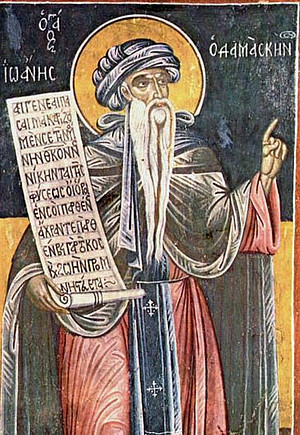John of Damascus
Accounts of the church fathers in the east generally terminate with John, who was born into an Arab-Christian family in Damascus. Following in the footsteps of his grandfather and father, he was well-educated for a position in the caliph’s court. Perhaps because of growing hostility to Christians in the court of Abd el-Malik (685-705), J. and his father withdrew from their administrative government positions. J. took up residence in the monastery of Mar Saba near Jerusalem. Patriarch John V of Jerusalem, who mentored him in theology, made J. a priest against his will in 726 and enlisted him in the iconographic controversy from that time onward. J. preached in Jerusalem, as well. While he was anathematized shortly after his death by Emperor Constantine V for his pro-icon writings, he was revived by the Second Council of Nicaea in 787.
His major dogmatic work was the Fountain of Knowledge, which includes philosophical chapters adducing the best in pagan philosophy, chapters on heresies (mostly using Epiphanius) and discussing Islam based on his own knowledge of that religion, and chapters on orthodox faith which focus on various loci of doctrine, most notably on Mariology, veneration of the saints and images, and eschatology. He also composed various works on the topic of Christology, especially ones against Nestorians, Monophysites, Monotheletes, and against Manichees. In the area of moral theology the Sacra parallela is a florilegium of biblical texts and is only partially authentic. He wrote a commentary on Paul, following the lead of John Chrysostom. In addition to a few hagiographical works, he surely composed seven sermons but the authenticity of others attributed to him is dubious. It is believed that J. had some share of authorship of the Oktoechos poem, and he certainly published several poetic works beyond that. Perhaps the work J. is most famous for are the three Discourses Concerning Images. These carefully analyze the terms “worship” and “icon” to show that prayer using images is not to the images themselves but to the things which they represent.
J. was a great compiler and synthesizer. He admits that he is not out to advance Christian theology, but rather to summarize and put it forward in ways important for the present time. However, his method of presenting the tradition may be seen as a creative activity in itself. He tries to take the middle ground of orthodoxy, which is especially seen in his consistent Chalcedonian Christology.
The last part of the Fountain of Knowledge came into the West in the mid-13th century as the Sententiae Damasceni, showing how closely related it was in the medieval mind to Peter Lombard’s systematization of Christian theology. From that time onward it held considerable sway in the West and his thought always has had a prominent place in Eastern theology, since his main contribution is synthesizing the great Greek theological tradition.
